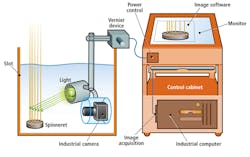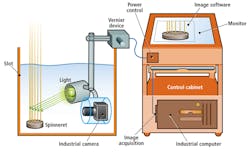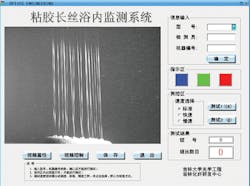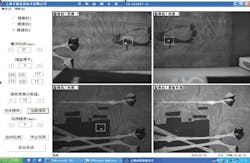MARKET NEWS: Textile China
By Chen Nan Yang
China leads the world in the scale of itstextile production industry; that industry is now undergoing three trends that will in turn boost the need for machine vision: the demand for improved precision and efficiency, increasing automation of textile machines, and climbing cost of labor.
“As the prices of raw materials keep rising, textile companies need to improve the precision of production processes to reduce the waste of raw materials,” says Gao Yong, vice president of the China Textile Industry Association (CTIA). According to Yong, after the global financial crisis, the rise of textile raw material prices has outpaced the rise of oil prices due to a supply shortfall, and this trend may continue. As a result, reducing raw material consumption has become critical and precision production much more important.
Yong adds, “Textile producers are also seeking to increase the automation of production machines to reduce labor costs and avoid the threat of a labor force shortage. Automated textile machine makers will benefit from this trend.” Salaries in textile manufacturing increased approximately 15% annually between 2004 and 2009. And, as the baby boom generation of the 1950s retires, the labor force shortage is becoming a serious problem for many Chinese textile producers.
“Not only can machine-vision technologies improve manufacturing precision,” says Gu Ren, president of machine-vision system integrator Changzhou Hongda Group, “but, as labor costs rise, investment in machine-vision systems will reduce costs. As a result, we expect that the market for machine vision in textile production will grow rapidly in the coming decade.”
Opportunities in textiles
According to Liu Shu Guang, professor at Xi’an Polytechnic University, machine-vision applications in the textile industry help support the production of fibers, yarns, and fabrics. These applications include inspecting:
- the orientation of fiber, diameter of fiber, weight uniformity of cotton web, maturity of cotton fiber, scale structure of wool and cashmere fiber, cross-section of high-molecular fiber, fiber curvature, monofilament quantities of viscose fiber, and fiber profile degree.
- yarn count, yarn linear density, yarn regularity, and blended yarn regularity.
- cockle effects of silk, reflective effects of silk, fabric defects, and dyeing and printing mistakes.
China produces more than half of the manmade fibers in the world. In the viscose-rayon fiber sector, China produced 1.51 million metric tons of viscose filaments and staple fibers in 2009, accounting for more than one-third of the global output. Traditionally, quality control for viscose filaments depends primarily on manual surveillance, which is difficult to execute during high-speed fiber production processes.
The most difficult quality-control challenge in viscose production is the quality of viscose monofilaments. In a viscose production line, each spinneret of a viscose machine has many small holes, and each hole produces a viscose monofilament with a diameter of less than 0.1 mm; many monofilaments are spun together to form a thread of viscose filament.
Spinneret holes are easily blocked by viscose pulp during the manufacturing process, which causes a difference in the number of monofilaments in viscose filaments. These irregular viscose filaments cannot be dyed with uniform colors, which reduces their quality and price.
To ensure the quality of viscose filaments, the Evoc High-tech Holdings Group has developed a viscose filament slot-monitoring system to automatically inspect spinneret holes and monofilament quantity. This system has been used in China’s viscose fiber production, including the production lines of Jilin Chemical Fiber, which has an annual capacity of 50,000 metric tons.
The system consists of a light source, industrial CCD camera, mechanical vernier device, control cabinet, electric power control panel, industrial personal computer, LCD monitor, image-acquisition card, and image-analysis software. The spinneret holes spit viscose monofilaments from the bottom up through a sulfur bath (see Fig. 1).
The light source and camera in this system must work in a slot full of sulfur bath with a depth of 400 mm and temperature of approximately 50°C. The environment is very harsh, with high acidity, severe erosion, high humidity, and high-frequency signals. In these conditions, the system can detect viscose spinnerets with 18 to 40 holes (each hole has a diameter of 0.06–0.08 mm) with a 97% accuracy.
System designers implement several measures to protect the system and devices. The light source and camera are sealed in an acid-proof, erosion-resistant, and transparent ABS (acrylonitrile butadiene styrene) plastic shell. The mechanical vernier device can provide fine adjustment for the position of the light source and camera.
A control cabinet for the system contains an Evoc IPC-6806W-E (A3) industrial PC, LCD monitor, electric power control panel, industrial PC, and image-acquisition card.
Filament monitoring system
One of the most difficult aspects of system design is acquiring clear images in the sulfur bath and correctly identifying the number of monofilaments. Evoc has written image-processing software in VC language to calculate this number.
This program can reduce the noise associated with images of viscose monofilaments and sharpen the image. The application binarizes the image and removes spots and blobs caused by floating objects and air bubbles in the sulfur bath (see Fig. 2).
If the system finds that the total monofilament quantity from a spinneret has been changed, it will send a message to the viscose production line to clean the spinneret holes, thus ensuring the regularity of viscose filaments.
This system can operate at a high precision rate (above 97%) for viscose spinnerets with 18 to 40 holes. If the number of holes increases to more than 40, the precision will decline. The developers say that the system can deal with up to 60 spinneret holes simultaneously.
Vision for fabric defects
Machine-vision technologies have also been used for detecting fabric defects. For example, East Hope has developed a machine-vision system for quality control in fabric production. This system must inspect different types of fabric with defects that vary in shape, color, location, and size. And it must catch these defects during a high-speed production process that in turn creates significant noise in the images.
To locate the defects under these situations, the system uses the color and blob tools ofCommon Vision Blox (CVB) from Stemmer Imaging. The color tool can turn the RGB model of an image to a CIE L*a*b model. The blob tool can binarize the image (using binary thresholding) and calculate the quantity, shape, location, orientation, and size of each fabric defect. Its precision can be set at five different levels. The minimum precision is 0.5 mm for a linear defect or 1 mm2 for a blob.
After the defects are analyzed, the system sends the results to the adjustment and control module. This module can automatically adjust the movement of the production lines while sending a warning message to the system operator. The system also includes a reporting and management module that provides real-time statistics and reports for the production manager.
Dyeing and printing
Currently there are more than 2500 large and mid-size dyeing and printing companies in China. These companies process approximately 60 billion meters of textile fabrics each year. Mistakes in textile dyeing and printing can cause spots, chromatic dislocation, incorrect patterns, and loss of colors or patterns.
To avoid these problems, East Hope has developed a machine-vision system for quality control in textile dyeing and printing processes. This system can save up to 10 dyeing and printing models in its database. By comparing the model image with the real-time images acquired by industrial cameras, the system can indentify defects and adjust the positions of dyeing and printing machines, while alerting the operator (see Fig. 3).
FIGURE 3. East Hope has developed a machine-vision system for the quality control in textile dyeing and printing. By comparing a model image (lower right) with the real-time images, the system can identify defects and adjust the positions of dyeing and printing machines.
Because the light intensity in dyeing and printing environments will change at different times of day, the system consists of a light-compensation system that automatically adjusts the intensity of the light source to help ensure the correctness of image comparison.
This system uses three or more linescan CCD cameras for high-speed operation. In low-speed operation, area-array cameras could be an alternative. The system can handle any dyeing and printing production line with a speed up to 100 m/min. At less than 80 m/min, its precision can reach 1.0 mm for a linear defect or 3 mm2 for a blob.
Rotary screen printing
Rotary screen printing dominates China’s fabric printing market, having the advantages of producing vivid colors at high speed with easy operation. According to the CTIA, rotary screen-printing machines account for more than 60% of China’s textile printing machines.
The precision of a rotary screen-printing machine can decline because of wear and tear and loosening of gears. As a result, real-time surveillance is very important to quality control; however, manual surveillance is inefficient and results in a high rate of defects.
Changzhou Hongda has developed a machine-vision system for rotary screen printing. It can identify and correct the wrong fabric patterns in a rotary screen-printing production line running at a speed up to 80 m/min. The precision of this system can reach 0.5 mm. Once the system catches a wrong pattern, it will send a series of impulses to the vernier device motors, which will automatically adjust the positions of the printing screen and thus avoid errors.
This system can use the Yongzhi Technology VC2913D camera, which has automatic gain control and backlight compensation modules to ensure consistent light intensity in the machine-vision environment.
Changzhou Hongda uses this system in rotary screen printing of traditional Chinese batik fabrics. The technologies of Chinese batik fabrics are complicated and the rate of finished products is usually very low. This system automatically adjusts the printing screens if they are not in the correct position, which reduces defect rates and improves the profits of batik fabric producers.
Chen Nan Yangis a contributing editor based in Hangzhou, China.
Company Info
Changzhou Hongda Group, Jiangsu, China
China Textile Industry Association,Beijing, China
East Hope, Wuxi, China
Evoc High-tech Holdings Group, Shenzhen, China
Stemmer Imaging, Puchheim, Germany
Yongzhi Technology, Chengdu, China
Vision Systems Articles Archives



